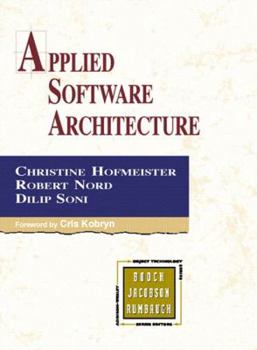Applied Software Architecture
Select Format
Select Condition 
Book Overview
requires juggling differing perspectives and differing goals, and evaluating differing options. Applied Software Architecture is the best book yet that gives guidance as to how to sort out and... This description may be from another edition of this product.
Format:Hardcover
Language:English
ISBN:0201325713
ISBN13:9780201325713
Release Date:January 1999
Publisher:Addison-Wesley Professional
Length:432 Pages
Weight:1.95 lbs.
Dimensions:9.8" x 1.3" x 7.8"
Customer Reviews
5 ratings
Good for the case studies
Published by Thriftbooks.com User , 21 years ago
This book is clear, solid, and workmanlike. It could work well as a textbook, or one of several texts for a term course. It gives a systematic introduction to several high-level notations, describing the conceptual, executable, structural (or module), and code views. Most of the notation is well-formed UML, and the authors take care to add semantic notes to every part of the graphical notation. They supplement the standard notations with a few text-based extensions. These capture requirements, archtiectural decisions, risks and risk mitigation, and other operating features of a living software project. One real asset is the related set of brief case studies at the end of the book, three separate products with a common conceptual base. This book is aging, it dates back to 1999 - five years, as I write this. That's old in the "architecture" literature, and the authors fail to apply the "product line" notion. I take this book for its good, though, and lack of one buzzword is a small enough fault. The book uses a process-and-pipe model pervasively for architectural description. It's a good tool, but other tools are good for other purposes, and their omission is a problem here. Still, the book is competent on the whole. Its sustained product-line example ties the whole together, and it focusses on practice intead of mainfestos and brand-name methodologies. There's a lot of good here, and you can pick out out easily. //wiredweird
A novel and thorough approach to software architecture
Published by Thriftbooks.com User , 23 years ago
Computer scientists at Siemens have developed an intriguing and very useful approach for describing the architecture of software systems. This book, written at a high level of quality, details a wide variety of factors that project managers and architects must consider during the course of planning, designing, and implementing small-, medium-, and large-scale projects. Backed by data from real-world examples, the authors present their ideas in a very understandable form and give software engineers many good ideas for improving the quality of their products.
Architects of the Architecture process
Published by Thriftbooks.com User , 24 years ago
OK. So you are a seasoned software engineer, 4th and 5th generation languages hold no secrets for you, design patterns are your credo, and you even have tackled this good old OMT technique. However, you still feel uneasy when it comes to translating use cases to risk management, and especially to take into account those interns who will develop part of the software.This book answers your questions by proposing both a technique and a language (UML extended), that will help you list the different factors affecting your project, infer the right design decisions, and document them throughout the project. For those with an analytical mind, the architecture process itself is decomposed and re-engineered. No consultant talk here : everything is explained, both in words and figures, using real world examples. Some will regret that the application field used for the demonstration is too narrow, since only real time applications are used, and there is no reference to database architecture or e-business ! But for those of the embedded world, such a book was awaited, and browsing (too) quickly through various application fields would have contented no one, anyhow.It is still a long reading, if you want to study all examples in depth - fortunately, you can start your own design after the first case study.Lastly, using UML throughout the project eases the communication with the development engineers, and it really helps when your team tackles detailed design.
This book is excellent!
Published by Thriftbooks.com User , 24 years ago
I am Software Architect at Siemens Medical Systems, Angiography Division in Chicago.I am involved with the architecture for a Angio Acquisition/Post processing system. I have read the book "Applied Software Architecture". It is excellent! I find it very helpful and use it as a reference for my architecture work.
Solid practical advice for practising architects
Published by Thriftbooks.com User , 25 years ago
The authors show how to practically apply software architecture principles by providing a process distilled from the collective wisdom of successful projects at Siemens.The organisational, product and technical factors affecting the development of a product are called out and the authors provide a means to systematically identify and classify each of these factors. The attempt to satisfy each factor inevitably leads to issues which must be addressed. By providing an issue card format that records the general solution and associated strategies, each issue can be comprehensively addressed. In fact new issues may be raised as a result of the adoption of a strategy and these new issues can be addressed in the same way.To me this clear linkage between the factors that affect the product development, the issues that arise, and the strategies that address them, is the most outstanding attribute of this book. My only quibble is that the examples given do not encompass business sofware development.Overall I heartily recommend this book as an excellent way of making sure that you are addressing the issues in your projects.





